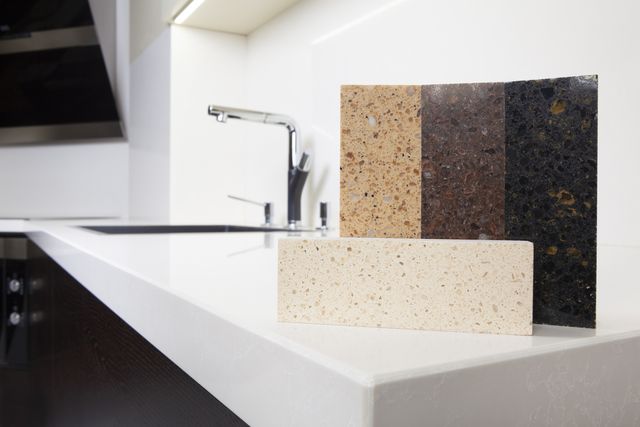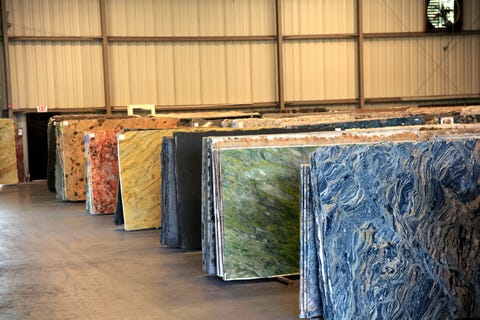Types of Countertops: How to Choose the Right Countertop Material for Your Kitchen

If you’re thinking about replacing your kitchen counters, and your timing couldn’t be better. Gone forever are the days when your only choices were plastic laminate or wood butcher block. Today, there are dozens of types of countertop available, ranging from natural-stone and porcelain sheets, to quartz composites, quartzite and marble. And countertops come in dozens of colors, patterns, and textures to satisfy any design goal.
Here, we’ll take a look at the most popular types of countertop materials: natural stone and engineered stone.
There’s no one countertop that’s ideal for every home, so the best material for your kitchen will depend on several factors: color, overall appearance, durability, stain- and scratch-resistance, and of course, price.
Natural Stone
A common type of countertop is natural stones like granite, marble, and Quartzite. Here’s a detailed look at each material:
Granite: Once found only in expensive, high-end kitchens, granite is more commonplace today and is by far the most popular natural-stone countertop material.
Granite comes in a wide array of colors, ranging from vibrant blues and variegated browns, to midnight black, deep red, and mottled white. It’s cut into long, thick slabs that require few—if any—seams. After the granite is cut and polished, it’s treated with an impregnating sealer that makes the countertop stain resistant while also sealing the natural pours in the stone. This treatment usually lasts five to ten years, but be sure to use a stone cleaner—not an abrasive cleanser—for everyday cleaning.
Most granite counters are polished to a glossy sheen, but you can also ask for a honed finish, which is much less shiny and more of a matte sheen. And leathered granite has a slightly textured surface that lends a rustic, casual look to a kitchen.
Pros: few, if any seams, extremely durable, very heat-resistant
Cons: must be sealed 5-10 years to resist stains
Marble: This is a high-end natural stone that comes in fewer color patterns than granite. Marble is also relatively soft and porous, so it’s not as stain resistant as granite. However, marble is regarded as a near-perfect work surface for activities like baking or making fresh pasta. Be careful when cutting, though, or marble may show knife scars.
Pros: classic look, striking natural patterns
Cons: needs repeated sealing
Quartzite: First off, quartzite is not quartz. It’s formed when quartz sandstone is exposed to high temperatures and pressure. These conditions re-crystallize the sand grains and silica cement that binds them. The result is a network of interlocking quartz grains of incredible strength. The beauty and strength of this natural stone make it a great countertop material for kitchens and bathrooms.
Pros: non-porous, stain resistant, subtle color complements virtually any kitchen decor
Cons: relatively soft, may show knife marks, few color options
Engineered Stone
Quartz: Another type of solid surfacing material that’s worth considering is called, quartz composite. Also known as engineered stone, this unique material is composed of about 90% quartz and 10% acrylic or epoxy binder. The main differences between engineered stone and traditional solid-surfacing materials are that engineered stone is much harder and has a depth, clarity and radiance not found in solid surfaces; this is due to the fact that engineered stone is completely compressed with 100% density.
Pros: extremely durable, very low-maintenance, wide array of colors and patterns
Cons: N/A
Porcelain: Essentially, porcelain is made from clay — but not just any type of clay. The clay used to create porcelain is often called China clay, and it contains a high percentage of a mineral known as kaolinite along with silica, feldspar and other mineral oxides which together are responsible for the strength and durability of porcelain.
This combo is put into a kiln and fired at extremely high temperatures. The result is a super dense material that is nearly completely impervious to stains, heat, UV rays, scratching, chips, and cracks.Pigmented glazes are added during manufacturing to create different colors and patterns on the porcelain slab countertop. Your porcelain can either be glazed or unglazed. A matte or high-gloss glaze (with or without a pattern) is applied, then it is fired a second time so that the glaze adheres completely.The glaze decreases porosity (and risk of staining), increases durability, and creates the shiny finish.
However, the pattern or color of glazed porcelain is only on the surface and does not go through the full body of the slab or tile. The interior color may be different and will show if the surface is chipped.
Pros: extremely durable, very low-maintenance, wide array of colors and patterns
Cons: finish is on the surface, may show knife marks
⊗ Avoid harsh acidic cleaners or food√s on the surface which may wear down the seal or shine over prolonged exposure
⊗ Avoid hot pots on pans over 450 degrees fahrenheit on the countertop
⊗ Avoid using the countertop as a cutting board
⊗ Dropping heavy items on surface.
√ Seal and maintain regularly

